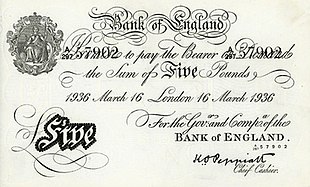
Back عملية بيرنهارد Arabic Операция „Бернхард“ Bulgarian Operació Bernhard Catalan Operace Bernhard Czech Aktion Bernhard German Επιχείρηση Μπέρνχαρντ Greek Operaco Bernhard Esperanto Operación Bernhard Spanish عملیات برنهارت Persian Opération Bernhard French

Operation Bernhard was an exercise by Nazi Germany to forge British bank notes. The initial plan was to drop the notes over Britain to bring about a collapse of the British economy during the Second World War. The first phase was run from early 1940 by the Sicherheitsdienst (SD) under the title Unternehmen Andreas (Operation Andreas). The unit successfully duplicated the rag paper used by the British, produced near-identical engraving blocks and deduced the algorithm used to create the alpha-numeric serial code on each note. The unit closed in early 1942 after its head, Alfred Naujocks, fell out of favour with his superior officer, Reinhard Heydrich.
The operation was revived later in the year; the aim was changed to forging money to finance German intelligence operations. Instead of a specialist unit within the SD, prisoners from Nazi concentration camps were selected and sent to Sachsenhausen concentration camp to work under SS Major Bernhard Krüger. The unit produced British notes until mid-1945; estimates vary of the number and value of notes printed, from £132.6 million up to £300 million. By the time the unit ceased production, they had perfected the artwork for US dollars, although the paper and serial numbers were still being analysed. The counterfeit money was laundered in exchange for money and other assets. Counterfeit notes from the operation were used to pay the Turkish agent Elyesa Bazna—code named Cicero—for his work in obtaining British secrets from the British ambassador in Ankara, and £100,000 from Operation Bernhard was used to obtain information that helped to free the Italian leader Benito Mussolini in the Gran Sasso raid in September 1943.
In early 1945 the unit was moved to Mauthausen-Gusen concentration camp in Austria, then to the Redl-Zipf series of tunnels and finally to Ebensee concentration camp. Because of an overly precise interpretation of a German order, the prisoners were not executed on their arrival; they were liberated shortly afterwards by the American Army. Much of the output of the unit was dumped into the Toplitz and Grundlsee lakes at the end of the war, but enough went into general circulation that the Bank of England stopped releasing new notes and issued a new design after the war. The operation has been dramatised in a comedy-drama miniseries Private Schulz by the BBC and in a 2007 film, The Counterfeiters (Die Fälscher).
© MMXXIII Rich X Search. We shall prevail. All rights reserved. Rich X Search